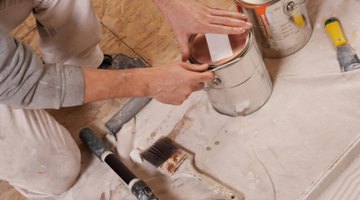Valspar Metallic Paint Glaze Directions
Valspar's line of Faux Finish paints and glazes give you an excellent opportunity to add a special touch to your paint job. Proper surface preparation and application, however, takes some serious and careful work.

Things You Will Need
- 1 gallon of Valspar Metallic Paint Glaze per 125 to 200 sq. ft. of painting surface (depending on surface porosity)
- 1 gallon of Valspar base coat per 350 to 400 sq. ft. of painting surface (depending on surface porosity)
- Professional-grade paintbrush
- Professional-grade roller
- Wallpaper smoothing brush
If you're willing to put in some extra time to give your paint job an extra special touch, Valspar's Metallic and Patina Glazes are a great way to do so.
-
Prepare your painting surface properly. Ensure that the surface is clean and free of debris and peeling paint. Tape off all moulding, baseboards and trim, and lay drop cloths over the floor to avoid splatters. If you're working with new wallboard, use a primer.
-
Apply a base coat. Many of Valspar's Faux Finishes call for a specific base coat, which can be mixed by your paint vendor. Otherwise, apply whichever base coat color suits your decor. Remove your tape and allow your base coat to dry for at least four hours or overnight before moving on to glazes.
-
Reapply your tape and apply your Metal Glaze in sections 4 to 6 feet wide, using rollers and brushes.
-
Work through your wet glaze with a wallpaper smoothing brush. Use a sweeping motion of large, overlapping arcs to allow the base color to show through the glaze in some spots. This will give the finish the look of brushed metal. Glaze remains workable for 30 minutes.
-
Repeat Steps 3 and 4, in 4-to-6 foot sections, until your entire painting surface is covered. Remove your tape and allow the glaze to dry overnight.
Tip
Avoid drafts from open windows and fans. Higher-end brushes, rollers and other tools make a difference. Remember that the result of your project should last for years and spend a little extra for good materials Adding a second coat will give your glaze a richer metallic sheen. For added protection, apply 1 gallon of Valspar® SignatureColors® FauxClear Protector per 400 sq. ft. of painting surface (depending on surface porosity) after all coats of glaze are dry.
Warning
When working with new wall coatings, always test first on a small, less-conspicuous area before proceeding.
Practice your paint and glaze technique on a practice board before applying it to the wall.
Read the entire label before using, especially all instructions and warnings.
References
Resources
Tips
- Avoid drafts from open windows and fans.
- Higher-end brushes, rollers and other tools make a difference. Remember that the result of your project should last for years and spend a little extra for good materials
- Adding a second coat will give your glaze a richer metallic sheen.
- For added protection, apply 1 gallon of Valspar® SignatureColors® FauxClear Protector per 400 sq. ft. of painting surface (depending on surface porosity) after all coats of glaze are dry.
Warnings
- When working with new wall coatings, always test first on a small, less-conspicuous area before proceeding.
- Practice your paint and glaze technique on a practice board before applying it to the wall.
- Read the entire label before using, especially all instructions and warnings.
Writer Bio
Matt Bell began writing professionally in 2003. Most of Bell's professional writing has come from the campaign trail, composing political literature and website content for candidates and campaigns. He holds a Master of Arts in diplomacy and international commerce from the University of Kentucky.
Photo Credits
- Jupiterimages/Photos.com/Getty Images
- Jupiterimages/Photos.com/Getty Images
More Articles



